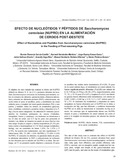Efecto de nucleótidos y péptidos de Saccharomyces cerevisiae (NUPRO) en la alimentación de cerdos post-destete

Ver/
Fecha
2014-04-09Autor
Palabras Clave
NUPRO, Efecto destete, TGI, Características de la canal, MetabolitosWeaning effect, Carcass characteristics, Metabolites
Metadatos
Mostrar el registro completo del ítemResumen
El objetivo de este estudio fue evaluar el efecto del NUPRO
(Alltech de México S. A. de C.V.), producto obtenido de levadura
Saccharomyces cerevisiae en lechones post-destete, sobre
el consumo de alimento, ganancia diaria, eficiencia alimenticia
y relación de eficiencia proteica (REP), sobrevivencia, así
como sobre el peso al sacrificio, peso y rendimiento de canal
caliente; peso y longitud del tracto gastro-intestinal (TGI) y sus
partes, y también sobre los niveles de metabolitos (glucosa,
urea, creatinina, colesterol y proteína total) y minerales (Ca, P,
Mg y Zn) en suero sanguíneo. Se utilizaron 81 lechones provenientes
de hembras primíparas de cruces (Yorkshire,
Hampshire, Duroc y Landrace). Los lechones se destetaron a
los 23 días de edad, con 5,71 kg de peso vivo promedio al
destete. Las dietas se basaron en pasta de soya Glycine max
más sorgo Sorghum vulgare y fueron isoproteicas (21,0% proteína
cruda) e isoenergéticas (3.110 Mcal energía metabolizable/
kg), con un contenido de lisina 1,33%; Ca 1,37% y P
0,74%. Se usaron tres tratamientos con tres repeticiones: T1
(dieta basal, DB); T2 (DB + 2,0% NUPRO) y T3 (DB + 4,0%
NUPRO). El consumo de alimento, la ganancia diaria de peso,
la eficiencia alimenticia, la REP y sobrevivencia de lechones
no fue afectado por la adición del NUPRO a la dieta. Sin embargo,
en T1 se presentó cuadro diarreico y anorexia. El peso al sacrificio fue similar entre tratamientos (P 0,05). El peso
de la canal caliente (kg) y el rendimiento en canal caliente (%)
fueron significativamente diferentes (P 0,05) con valores de
6,18; 7,55 kg y 6,78 kg y 49; 58 y 57%, respectivamente, para
T1, T2, y T3. El peso (P 0,07) y longitud (P 0,01) del intestino
grueso fueron diferentes entre tratamientos, con valores de
0,260; 0,390 y 0,340 kg y 2,15; 3,11 y 2,27 metros para T1,
T2 y T3. El contenido de metabolitos y minerales en suero
sanguíneo no fueron afectados por el NUPRO en la dieta, a
excepción del Mg, que fue diferente y conforme incrementa
NUPRO en la dieta se incrementa el contenido de Mg en el
suero. Se concluye que al suplementar dietas con NUPRO
mejora el peso y rendimiento de canal caliente así como el
peso y la longitud de intestino grueso, sin afectar las demás
variables.
Colecciones
Información Adicional
| Otros Títulos | Effect of nucleotides and peptides from Saccharomyces cerevisiae (NUPRO) in the feeding of post-weaning pigs |
| Correo Electrónico | gacr430421@gmail.com |
| ISSN | 0798-2259 |
| Resumen en otro Idioma | The aim of this study was to evaluate the effect of NUPRO (Alltech de Mexico SA de CV), product obtained from yeast Saccharomyces cerevisiae in post-weaning piglets, on feed intake, daily gain, feed efficiency and protein efficiency ratio (PER ), survival, and on slaughter weight, weight and hot carcass yield, weight and length of the gastro-intestinal tract (GIT) and its parts, and also on the levels of metabolites (glucose, urea, creatinine, cholesterol and total protein) and minerals (Ca, P, Mg and Zn) in blood serum. It was used 81 crossbred piglets from primiparous sows of crosses (Yorkshire, Hampshire, Duroc and Landrace). The piglets were weaned at 23 days of age, with 5.71 kg live weight in average at weaning. The diets were based on soybean meal Glycine max plus sorghum vulgare and were isoproteic (21.0% crude protein) and isocaloric (3,110 Mcal metabolizable energy/kg), with a concentration of 1.33% lysine; 1.37% Ca, and 0.74% P. It was used three treatments with three replications: T1 (basal diet, BD), T2 (BD + 2.0% NUPRO) and T3 (BD + 4.0% NUPRO). Feed intake, daily weight gain, feed efficiency, PER and piglet survivals were not affected by the addition of NUPRO to diet. However, in T1 was presented diarrheal and anorexia. The slaughter weight was similar among treatments (P 0.05). The hot carcass weight (kg) and hot carcass yield (%) were significantly different (P 0.05) with values of 6.18, 7.55 kg and 6.78 kg and 49, 58 and 57%, respectively for T1, T2, and T3. The weight (P 0.07) and length (P 0.01) of the large intestine differed between treatments, with respective values of 0.260, 0.390 and 0.340 kg and 2.15, 3.11 and 2.27 meters for T1, T2 and T3. The concentration of metabolites and minerals in blood serum were not affected by the NUPRO in diet, except for Mg, which was different; as in the diet increases NUPRO increases the Mg concentration in serum. It is concluded that supplementing diets with NUPRO improves weight and yields of hot carcass and the weight and length of the large intestine, without affecting the other variables. |
| Colación | 29-37 |
| País | Venezuela |
| Institución | Universidad del Zulia (LUZ) Universidad de Los Andes (ULA) |
| Publicación Electrónica | Revista Científica |
| Sección | Revista Científica: Medicina Veterinaria |





